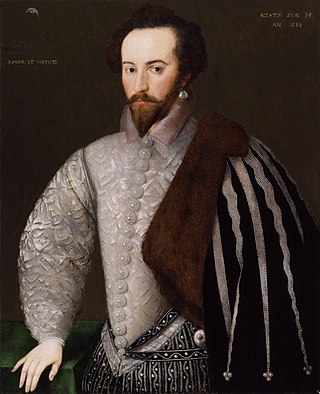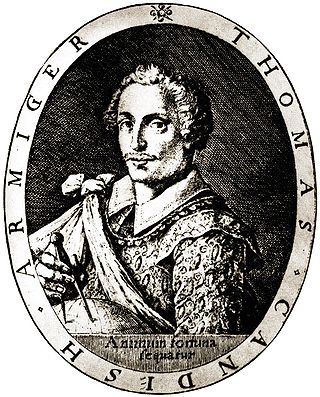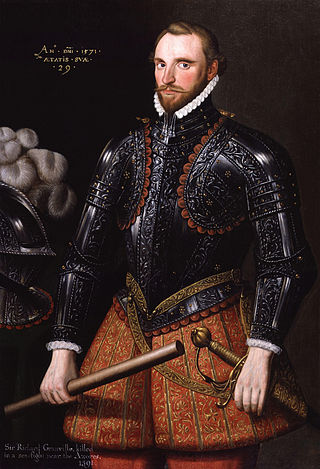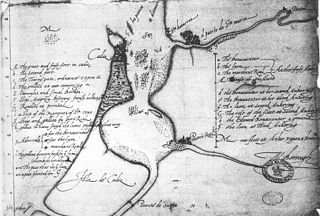
Sir Francis Drake was an English explorer and privateer best known for his circumnavigation of the world in a single expedition between 1577 and 1580. This was the first English circumnavigation, and third circumnavigation overall. He is also known for participating in the early English slaving voyages of his cousin, Sir John Hawkins, and John Lovell. Having started as a simple seaman, in 1588 he was part of the fight against the Spanish Armada as a vice-admiral.

Sir Walter Raleigh was an English statesman, soldier, writer and explorer. One of the most notable figures of the Elizabethan era, he played a leading part in English colonisation of North America, suppressed rebellion in Ireland, helped defend England against the Spanish Armada and held political positions under Elizabeth I.

John White was an English colonial governor, explorer, artist, and cartographer. White was among those who sailed with Richard Grenville in the first attempt to colonize Roanoke Island in 1585, acting as artist and mapmaker to the expedition. He would most famously briefly serve as the governor of the second attempt to found Roanoke Colony on the same island in 1587 and discover the colonists had mysteriously vanished.

The establishment of the Roanoke Colony was an attempt by Sir Walter Raleigh to found the first permanent English settlement in North America. The colony was first founded in 1585, but the colonists had disappeared under unknown circumstances when a ship visited the colony five years later in 1590. The colony has since been known as the Lost Colony, and the fate of the 112 to 121 colonists remains unknown to this day.

Sir Thomas Cavendish was an English explorer and a privateer known as "The Navigator" because he was the first who deliberately tried to emulate Sir Francis Drake and raid the Spanish towns and ships in the Pacific and return by circumnavigating the globe. Magellan's, Loaisa's, Drake's, and Loyola's expeditions had preceded Cavendish in circumnavigating the globe. His first trip and successful circumnavigation made him rich from captured Spanish gold, silk and treasure from the Pacific and the Philippines. His richest prize was the captured 600-ton sailing ship the Manila Galleon Santa Ana. He was knighted by Queen Elizabeth I of England after his return. He later set out for a second raiding and circumnavigation trip but was not as fortunate and died at sea at the age of 31.

Sir Richard Grenville, also spelt Greynvile, Greeneville, and Greenfield, was an English privateer and explorer. Grenville was lord of the manors of Stowe, Cornwall and Bideford, Devon. He subsequently participated in the plantations of Ireland specifically the Munster plantations, the English colonisation of the Americas and the repulse of the Spanish Armada.

Sir Ralph Lane was an English explorer of the Elizabethan era. He helped colonise the Kingdom of Ireland in 1583 and was sheriff of County Kerry, Ireland, from 1583 to 1585. He was part of the unsuccessful attempt in 1585 to colonise Roanoke Island, North Carolina. He was knighted by the Queen in 1593.

The Anglo-Spanish War (1585–1604) was an intermittent conflict between the Habsburg Kingdom of Spain and the Kingdom of England. It was never formally declared. The war included much English privateering against Spanish ships, and several widely separated battles. It began with England's military expedition in 1585 to what was then the Spanish Netherlands under the command of the Earl of Leicester, in support of the Dutch rebellion against Spanish Habsburg rule.

Singeing the King of Spain's Beard is the derisive name given to a series of attacks by the English privateer Francis Drake against the Spanish in the summer of 1587, beginning in April with a raid on Cádiz. This was an attack on the Spanish naval forces assembling in the Bay of Cádiz in preparation for the planned expedition against England. Much of the Spanish fleet was destroyed, and substantial supplies were destroyed or captured. There followed a series of raiding parties against several forts along the Portuguese coast. A Spanish treasure ship, returning from the Indies, was also captured. The damage caused by the English delayed Spanish preparations for the Armada by at least a year.

The Sea Dogs were a group of English privateers and explorers authorised by Queen Elizabeth I to raid England's enemies, whether they were formally at war with them or not. Active from 1560 until Elizabeth's death in 1603, the Sea Dogs primarily attacked Spanish targets both on land and at sea, particularly during the Anglo-Spanish War. Members of the Sea Dogs, including Sir John Hawkins and Sir Francis Drake, also engaged in illicit slave trading with Spanish colonies in the Americas.
Simon Fernandes was a 16th-century Portuguese-born navigator and sometime pirate who piloted the 1585 and 1587 English expeditions to found colonies on Roanoke island, part of modern-day North Carolina but then known as Virginia. Fernandes trained as a navigator in Spain at the famed Casa de Contratación in Seville, but later took up arms against the Spanish empire, preying upon Spanish shipping along with fellow pirate John Callis. Charged with piracy in 1577, he was saved from the hangman's noose by Sir Francis Walsingham, becoming a Protestant and a subject of the Queen of England. In 1578 Fernandes entered the service of Sir Humphrey Gilbert and later Sir Walter Raleigh, piloting the failed 1587 expedition to Roanoke, known to history as the "Lost Colony".

The English overseas possessions, also known as the English colonial empire, comprised a variety of overseas territories that were colonised, conquered, or otherwise acquired by the former Kingdom of England during the centuries before the Acts of Union of 1707 between the Kingdom of England and the Kingdom of Scotland created the Kingdom of Great Britain. The many English possessions then became the foundation of the British Empire and its fast-growing naval and mercantile power, which until then had yet to overtake those of the Dutch Republic, the Kingdom of Portugal, and the Crown of Castile.

Sir Bernard Drake of Ash in the parish of Musbury, Devon, was an English sea captain. He himself refuted any familial relationship with his contemporary the great Admiral Sir Francis Drake, as their dispute concerning armorials reveals. In fact, Sir Bernard Drake's grandparents John Drake V 1474-1554 and his wife Margaret were also the grandparents of Sir Francis Drake; Sir Bernard being descended from an older son and Francis descended from a younger son.

The Battle of Cartagena de Indias (1586) or the Capture of Cartagena de Indias was a military and naval action fought on 9–11 February 1586, of the recently declared Anglo-Spanish War that resulted in the assault and capture by English soldiers and sailors of the Spanish colony city of Cartagena de Indias governed by Pedro de Bustos on the Spanish Main. The English were led by Francis Drake. The raid was part of his Great Expedition to the Spanish New World. The English soldiers then occupied the city for over two months and captured much booty along with a ransom before departing on 12 April.

The Battle of Flores (1592), also known as Cruising Voyage to the Azores of 1592, or the Capture of the Madre de Deus describes a series of naval engagements that took place from 20 May to 19 August 1592, during the Anglo-Spanish War. The battle was part of an expedition by an English fleet initially led by Sir Walter Raleigh, and then by Martin Frobisher and John Burrough. The expedition involved the capture of a number of Portuguese and Spanish ships including the large Portuguese carrack Madre de Deus, after a long naval battle off the island of Flores in the Azores. The expedition, particularly the capture of the great carrack, was a financial and military success. The rich cargo aboard the carrack, which at the time equaled nearly half the size of the Kingdom of England's royal annual revenue, was subject to mass theft when it arrived in Dartmouth, England, followed by quarrels over the shares of the prize. The expedition had formative consequences for the English both financially and on the future of English exploration.

The Capture of Santiago was a military engagement that took place between 11 and 28 November 1585 during the newly declared Anglo-Spanish War. An English expedition led by Francis Drake captured the port town of Cidade Velha in the Cape Verde islands that had recently belonged to the Crown of Portugal. He sacked it and then marched inland before doing the same at São Domingos and Praia. Afterwards Drake left and continued his expedition to successfully raid the Spanish possessions in the Americas.

The Blockade of Western Cuba, also known as the Watts' West Indies Expedition of 1591, was an English privateering naval operation that took place off the Spanish colonial island of Cuba in the Caribbean during the Anglo–Spanish War. The expedition along with the blockade took place between May and July 1591 led by Ralph Lane and Michael Geare with a large financial investment from John Watts and Sir Walter Raleigh. They intercepted and took a number of Spanish ships, some of which belonged to a Spanish plate convoy of Admiral Antonio Navarro, and protected by the Spanish navy under Admiral Diego de la Ribera intending to rid English privateers. The English took or burnt a total of ten Spanish ships including two galleons, one of which was a valuable prize. With this success and the loss of only one ship the blockade and expedition was terminated for the return to England. The blockade was one of the most successful English expeditions to the Spanish Main during the war militarily and financially.

Watts' West Indies and Virginia expedition also known as the Action of Cape Tiburon was an English expedition to the Spanish Main during the Anglo–Spanish War. The expedition began on 10 May and ended by 18 July 1590 and was commanded by Abraham Cocke and Christopher Newport. This was financed by the highly renowned London merchant John Watts. The English ships intercepted and dispersed Spanish convoys capturing, sinking, and grounding many ships off the Spanish colonies of Hispaniola, Cuba, and Jamaica. Despite losing an arm, Newport was victorious and captured a good haul of booty. A breakaway expedition from this discovered that the Roanoke Colony was completely deserted and which gave the name The Lost Colony.

The action off Bermuda, also known as Grenville's action off the Bermuda's, was a minor naval engagement that took place off the island of Bermuda over three days in late August 1585 during the Anglo–Spanish War between an English galleass, Tiger, and a larger Spanish galleon, Santa Maria de San Vicente. Tiger was victorious when the Spanish ship surrendered after a severe bombardment.

Francis Drake's circumnavigation, also known as Drake's Raiding Expedition, was an important historical maritime event that took place between 15 December 1577 and 26 September 1580. The expedition was authorised by Queen Elizabeth I and consisted of five ships led by Francis Drake. Termed a 'voyage of discovery', it was in effect an ambitious covert raiding voyage and the start of England's challenge to the global domination of Spain and Portugal.



















